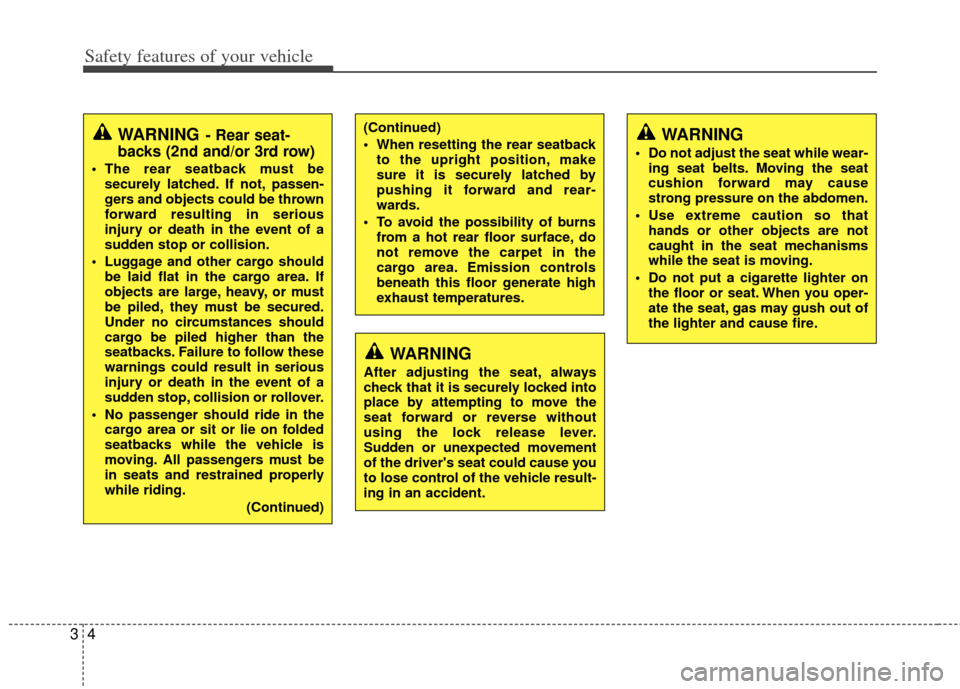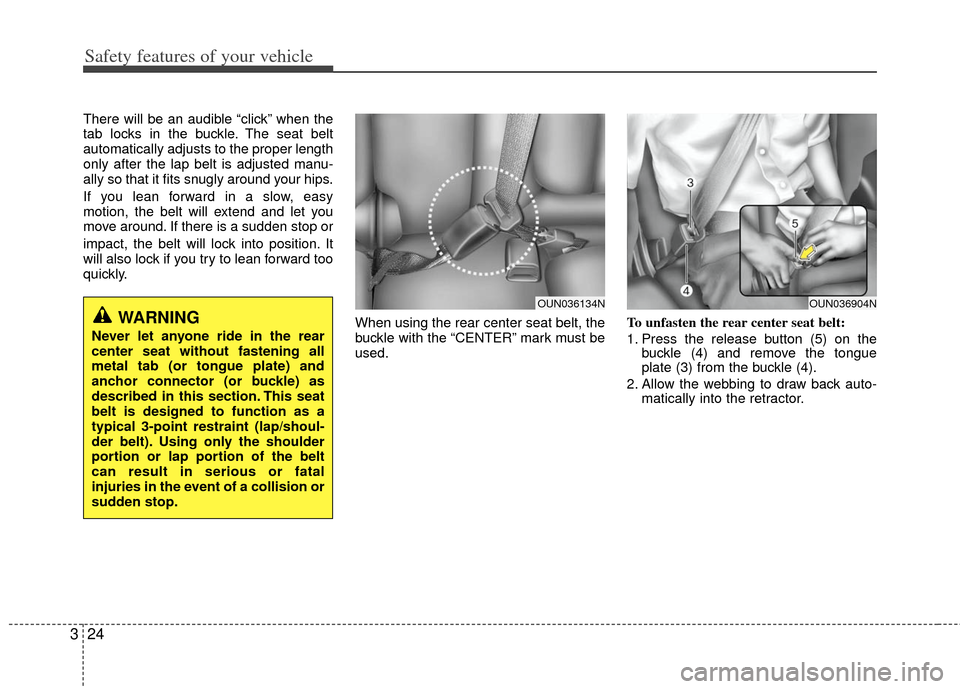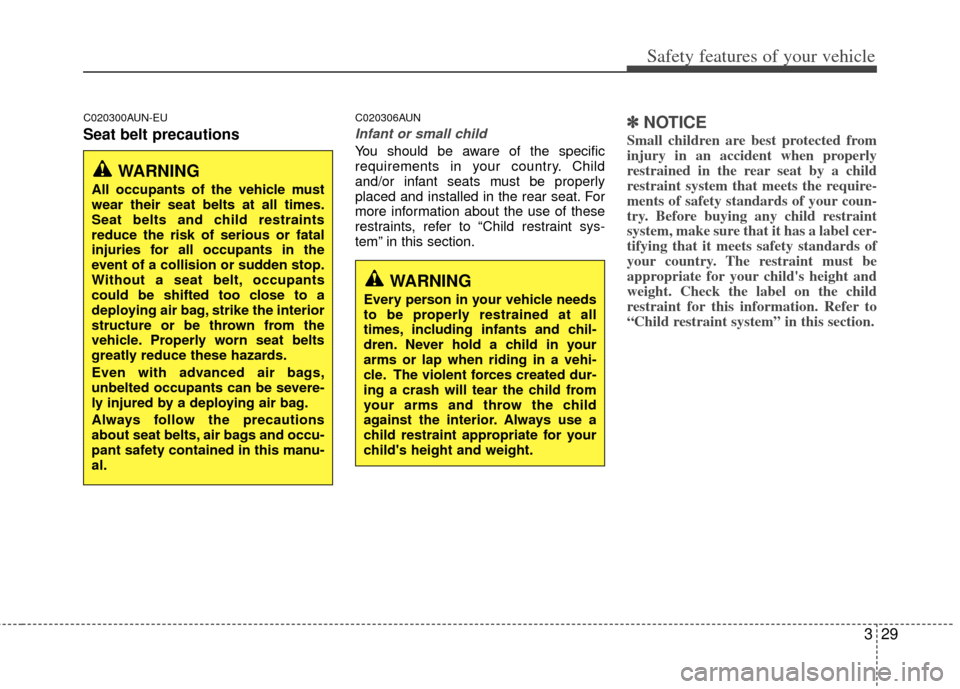2013 KIA Carens Restrain
[x] Cancel search: RestrainPage 5 of 338

Index
2I
Air bag-advanced supplemental restraint system ··········3-40
Air cleaner ··················\
··················\
··················\
···············7-25
Appearance care··················\
··················\
··················\
·······7-53
Audio system ··················\
··················\
··················\
···········4-92
Automatic climate control system ··················\
···············4-70
Automatic transaxle ··················\
··················\
··················\
···5-7
Automatic transaxle fluid ··················\
··················\
··········7-22
Battery··················\
··················\
··················\
··················\
····7-28
Before driving ··················\
··················\
··················\
············5-3
Brake system··················\
··················\
··················\
············5-14
Brakes fluid··················\
··················\
··················\
··············7-20
Bulb wattage ··················\
··················\
··················\
··············8-2
Child restraint system ··················\
··················\
················3-32
Climate control air filter ··················\
··················\
············7-25
Cruise control system ··················\
··················\
················5-24
Defroster ··················\
··················\
··················\
··················\
4-59
Dimensions ··················\
··················\
··················\
················8-2Door locks··················\
··················\
··················\
··················\
4-9
Economical operation ··················\
··················\
················5-28
Emergency starting ··················\
··················\
··················\
····6-4
Emission control system ··················\
··················\
············7-59
Engine compartment ··················\
··················\
·············2-4/7-2
Engine coolant ··················\
··················\
··················\
·········7-17
Engine number ··················\
··················\
··················\
···········8-7
Engine oil ··················\
··················\
··················\
·················7-16\
Explanation of scheduled maintenance items ···············7-12
Exterior feature ··················\
··················\
··················\
········4-90
Fuel filler lid ··················\
··················\
··················\
············4-20
Fuel requirements ··················\
··················\
··················\
······1-3
Fuses ··················\
··················\
··················\
··················\
······7-44
Hazard warning flasher ··················\
··················\
··············4-50
Hood··················\
··················\
··················\
··················\
·······4-18
How to use this manual ··················\
··················\
···············1-2
A
B
C
D
E
F
H
Page 18 of 338

3
Seats / 3-2
Seat belts / 3-18
Child restraint system / 3-32
Air bag-advanced supplemental restraint system / 3-40
Safety features of your vehicle
Page 21 of 338

Safety features of your vehicle
43
(Continued)
When resetting the rear seatbackto the upright position, make
sure it is securely latched by
pushing it forward and rear-
wards.
To avoid the possibility of burns from a hot rear floor surface, do
not remove the carpet in the
cargo area. Emission controls
beneath this floor generate high
exhaust temperatures.
WARNING
After adjusting the seat, always
check that it is securely locked into
place by attempting to move the
seat forward or reverse without
using the lock release lever.
Sudden or unexpected movement
of the driver's seat could cause you
to lose control of the vehicle result-
ing in an accident.
WARNING- Rear seat-
backs (2nd and/or 3rd row)
The rear seatback must be
securely latched. If not, passen-
gers and objects could be thrown
forward resulting in serious
injury or death in the event of a
sudden stop or collision.
Luggage and other cargo should be laid flat in the cargo area. If
objects are large, heavy, or must
be piled, they must be secured.
Under no circumstances should
cargo be piled higher than the
seatbacks. Failure to follow these
warnings could result in serious
injury or death in the event of a
sudden stop, collision or rollover.
No passenger should ride in the cargo area or sit or lie on folded
seatbacks while the vehicle is
moving. All passengers must be
in seats and restrained properly
while riding.
(Continued)
WARNING
Do not adjust the seat while wear-ing seat belts. Moving the seat
cushion forward may cause
strong pressure on the abdomen.
Use extreme caution so that hands or other objects are not
caught in the seat mechanisms
while the seat is moving.
Do not put a cigarette lighter on the floor or seat. When you oper-
ate the seat, gas may gush out of
the lighter and cause fire.
Page 35 of 338

Safety features of your vehicle
18
3
C020100AUN
Seat belt restraint system
C020101BUN-EU
Seat belt warning
Driver's seat belt warning
As a reminder to the driver, the seat belt
warning light will blink for approximately
6 seconds each time you turn the ignition
switch ON regardless of belt fastening.
If the driver's seat belt is not fastened
when the ignition switch is turned ON,
the seat belt warning light and chime will
operate for approximately 6 seconds. The
warning chime will stop at once if the
seat belt is fastened.
If the driver's seat belt is disconnected
after the ignition switch is turned ON, the
seat belt warning light (and chime - the
vehicle speed is over 5 km/h (3 mph)) will
operate for approximately 6 seconds.
SEAT BELTS
WARNING
For maximum restraint system
protection, the seat belts must
always be used whenever the car
is moving.
Seat belts are most effective when seatbacks are in the
upright position.
Children age 12 and under must always be properly restrained in
the rear seat. Never allow chil-
dren to ride in the front passen-
ger seat. If a child over 12 must
be seated in the front seat, he/she
must be properly belted and the
seat should be moved as far back
as possible.
Never wear the shoulder belt under your arm or behind your
back. An improperly positioned
shoulder belt can cause serious
injuries in a crash. The shoulder
belt should be positioned midway
over your shoulder across your
collarbone.
(Continued)
(Continued)
Avoid wearing twisted seat belts.A twisted belt can't do its job as
well. In a collision, it could even
cut into you. Be sure the belt
webbing is straight and not twist-
ed.
Be careful not to damage the belt webbing or hardware. If the belt
webbing or hardware is dam-
aged, replace it.
When you fasten the seat belt, be careful not to latch the seat belt in
buckles of other seat. It's very dan-
gerous and you may not be pro-
tected by the seat belt properly.
Do not unfasten the seat belt and do not fasten and unfasten the
seat belt repeatedly while driving.
This could result in loss of con-
trol, and an accident causing
death, serious injury, or property
damage.
When fastening the seat belt, make sure that the seat belt does
not pass over objects that are
hard or can break easily.
Make sure there is nothing in the buckle. The seat belt may not be
fastened securely.
OUN036023N
Page 38 of 338

321
Safety features of your vehicle
To raise the height adjuster, pull it up (1).
To lower it, push it down (3) while press-
ing the height adjuster button (2).
Release the button to lock the anchor
into position. Try sliding the height
adjuster to make sure that it has locked
into position.C020106AUN
Seat belts - Front passenger and rearseat 3-point system with combination locking retractor
To fasten your seat belt:
Combination retractor type seat belts are
installed in the rear seat positions to help
accommodate the installation of child
restraint systems. Although a combina-
tion retractor is also installed in the front
passenger seat position, it is strongly
recommended that children always be
seated in the rear seat. NEVER place
any infant restraint system in the front
seat of the vehicle.
This type of seat belt combines the fea-
tures of both an emergency locking
retractor seat belt and an automatic lock-
ing retractor seat belt. To fasten your seat
belt, pull it out of the retractor and insert
the metal tab into the buckle. There will
be an audible "click" when the tab locks
into the buckle. When not securing a
child restraint, the seat belt operates in
the same way as the driver's seat belt
(Emergency Locking Retractor Type). It
automatically adjusts to the proper length
only after the lap belt portion of the seat
belt is adjusted manually so that it fits
snugly around your hips.
WARNING
Verify the shoulder belt anchor is locked into position at the appro-
priate height. Never position the
shoulder belt across your neck or
face. Improperly positioned seat
belts can cause serious injuries
in an accident.
Failure to replace seat belts after an accident could leave you with
damaged seat belts that will not
provide protection in the event of
another collision leading to per-
sonal injury or death. Replace
your seat belts after being in an
accident as soon as possible.
WARNING
You should place the lap belt por-
tion as low as possible and snugly
across your hips, not on your waist.
If the lap belt is located too high on
your waist, it may increase the
chance of injury in the event of a
collision. Both arms should not be
under or over the belt. Rather, one
should be over and the other under,
as shown in the illustration.
Never wear the seat belt under the
arm nearest the door.
B200A02NF
Page 39 of 338

Safety features of your vehicle
22
3
When the seat belt is fully extended from
the retractor to allow the installation of a
child restraint system, the seat belt oper-
ation changes to allow the belt to retract,
but not to extend (Automatic Locking
Retractor Type). Refer to “Using a child
restraint system” in this section.
✽ ✽
NOTICE
Although the combination retractor
provides the same level of protection for
seated passengers in either emergency
or automatic locking modes, it is recom-
mended that seated passengers use the
emergency locking feature for improved
convenience. The automatic locking
function is intended to facilitate child
restraint installation. To convert from
the automatic locking feature to the
emergency locking operation mode,
allow the unbuckled seat belt to fully
retract.
When using the rear center seat belt, the
buckle with the “CENTER” mark must be
used. To release the seat belt:
The seat belt is released by pressing the
release button (1) in the locking buckle.
When it is released, the belt should auto-
matically draw back into the retractor.
If this does not happen, check the belt to
be sure it is not twisted, then try again.
B210A01NF1OUN026131N
Page 41 of 338

Safety features of your vehicle
24
3
There will be an audible “click” when the
tab locks in the buckle. The seat belt
automatically adjusts to the proper length
only after the lap belt is adjusted manu-
ally so that it fits snugly around your hips.
If you lean forward in a slow, easy
motion, the belt will extend and let you
move around. If there is a sudden stop or
impact, the belt will lock into position. It
will also lock if you try to lean forward too
quickly.
When using the rear center seat belt, the
buckle with the “CENTER” mark must be
used.To unfasten the rear center seat belt:
1. Press the release button (5) on the
buckle (4) and remove the tongue
plate (3) from the buckle (4).
2. Allow the webbing to draw back auto- matically into the retractor.
WARNING
Never let anyone ride in the rear
center seat without fastening all
metal tab (or tongue plate) and
anchor connector (or buckle) as
described in this section. This seat
belt is designed to function as a
typical 3-point restraint (lap/shoul-
der belt). Using only the shoulder
portion or lap portion of the belt
can result in serious or fatal
injuries in the event of a collision or
sudden stop.
OUN036134NOUN036904N
Page 46 of 338

329
Safety features of your vehicle
C020300AUN-EU
Seat belt precautions
C020306AUN
Infant or small child
You should be aware of the specific
requirements in your country. Child
and/or infant seats must be properly
placed and installed in the rear seat. For
more information about the use of these
restraints, refer to “Child restraint sys-
tem” in this section.
✽ ✽NOTICE
Small children are best protected from
injury in an accident when properly
restrained in the rear seat by a child
restraint system that meets the require-
ments of safety standards of your coun-
try. Before buying any child restraint
system, make sure that it has a label cer-
tifying that it meets safety standards of
your country. The restraint must be
appropriate for your child's height and
weight. Check the label on the child
restraint for this information. Refer to
“Child restraint system” in this section.
WARNING
Every person in your vehicle needs
to be properly restrained at all
times, including infants and chil-
dren. Never hold a child in your
arms or lap when riding in a vehi-
cle. The violent forces created dur-
ing a crash will tear the child from
your arms and throw the child
against the interior. Always use a
child restraint appropriate for your
child's height and weight.
WARNING
All occupants of the vehicle must
wear their seat belts at all times.
Seat belts and child restraints
reduce the risk of serious or fatal
injuries for all occupants in the
event of a collision or sudden stop.
Without a seat belt, occupants
could be shifted too close to a
deploying air bag, strike the interior
structure or be thrown from the
vehicle. Properly worn seat belts
greatly reduce these hazards.
Even with advanced air bags,
unbelted occupants can be severe-
ly injured by a deploying air bag.
Always follow the precautions
about seat belts, air bags and occu-
pant safety contained in this manu-
al.